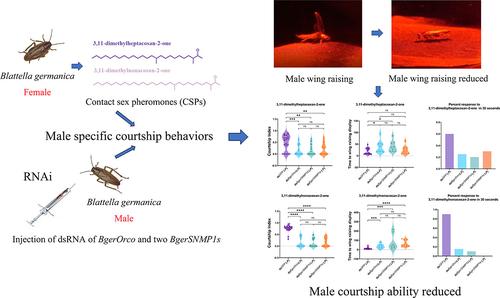当前位置:
X-MOL 学术
›
Pest Manag. Sci.
›
论文详情
Our official English website, www.x-mol.net, welcomes your
feedback! (Note: you will need to create a separate account there.)
Female contact sex pheromone recognition in the German cockroach (Blattella germanica) is mediated by two male antennae‐enriched sensory neuron membrane proteins
Pest Management Science ( IF 3.8 ) Pub Date : 2024-11-07 , DOI: 10.1002/ps.8530 Hong‐Yan Feng, Ya‐Qin Zhao, Tao Yang, Yang‐Yuntao Zhou, Lang‐Lang Gong, Meng‐Qi Zhang, Yun‐Feng Ma, J. Joe Hull, Youssef Dewer, Fan Zhang, Guy Smagghe, Ming He, Peng He
Pest Management Science ( IF 3.8 ) Pub Date : 2024-11-07 , DOI: 10.1002/ps.8530 Hong‐Yan Feng, Ya‐Qin Zhao, Tao Yang, Yang‐Yuntao Zhou, Lang‐Lang Gong, Meng‐Qi Zhang, Yun‐Feng Ma, J. Joe Hull, Youssef Dewer, Fan Zhang, Guy Smagghe, Ming He, Peng He

|
BACKGROUNDThe German cockroach Blattella germanica is a notorious urban health pest that has developed resistance to multiple pesticides. Thus, novel non‐lethal pest control agents are urgently needed. Olfaction interference via disruption of sex pheromone recognition‐related genes offers a promising approach. The German cockroach has a unique courtship behavior in which female adults emit contact sex pheromones (CSPs) in response to antennal touching, which subsequently triggers distinctive male sex behavioral responses. Due to the limited volatility of CSPs, the molecular mechanisms underlying their recognition and the specific olfactory pathways activated remain poorly defined. Although the odorant receptor coreceptor (Orco ) is critical for most insect olfaction, sensory neuron membrane proteins (SNMPs ), in particular SNMP1 , also play crucial roles in sex pheromone recognition in moths and flies. While multiple SNMP1 homologs have been identified in multiple insect species, they have yet to be fully functionally characterized in cockroaches.RESULTSIn this study, RNA‐interference (RNAi)‐mediated knockdown of BgerOrco reduced both the electrophysiology responses and courtship behaviors of males, indicating CSP perception proceeds via an olfaction pathway. Similar RNAi knockdown of BgerSNMP1e and BgerSNMP1d , which are predominantly expressed in male antennae, revealed critical roles in perceiving the major component of the Blattella germanica CSP blend. Unlike BgerSNMP1e , BgerSNMP1d was also found to function in the perception of the minor CSP component. Molecular docking analyses revealed no differences in the binding affinities of BgerSNMP1d for the major and minor CSP components, whereas the binding affinities of BgerSNMP1e displayed clear selectivity for the major component.CONCLUSIONOur results show that the olfactory pathway is critical for CSP recognition and that two male‐enriched SNMP genes, BgerSNMP1e and BgerSNMP1d , are crucial factors mediating the male response to CSP stimulation in German cockroaches. This study lays a foundation for studying the mechanisms of CSP recognition and provides novel molecular targets with potential to be exploited as disruptors of courtship behavior. © 2024 Society of Chemical Industry.
中文翻译:

德国蟑螂 (Blattella germanica) 中的雌性接触性信息素识别是由两种雄性富含触角的感觉神经元膜蛋白介导的
背景德国蟑螂 Blattella germanica 是一种臭名昭著的城市健康害虫,已经对多种杀虫剂产生了耐药性。因此,迫切需要新型非致命害虫防治剂。通过破坏性信息素识别相关基因进行嗅觉干扰提供了一种很有前途的方法。德国蟑螂具有独特的求偶行为,其中雌性成蟑螂在触角接触后会发出接触性信息素 (CSP),随后触发独特的雄性性行为反应。由于 CSP 的波动性有限,其识别的分子机制和激活的特定嗅觉途径仍然不清楚。尽管气味受体辅助受体 (Orco) 对大多数昆虫的嗅觉至关重要,但感觉神经元膜蛋白 (SNMP),特别是 SNMP1,在飞蛾和苍蝇的性信息素识别中也起着至关重要的作用。虽然已在多种昆虫物种中鉴定出多个 SNMP1 同源物,但它们尚未在蟑螂中得到充分的功能表征。结果在这项研究中,RNA 干扰 (RNAi) 介导的 BgerOrco 敲低降低了雄性的电生理反应和求偶行为,表明 CSP 感知通过嗅觉途径进行。BgerSNMP1e 和 BgerSNMP1d 的类似 RNAi 敲低主要在雄性触角中表达,揭示了在感知 Blattella germanica CSP 混合物的主要成分中的关键作用。与 BgerSNMP1e 不同,BgerSNMP1d 也被发现在次要 CSP 组件的感知中起作用。 分子对接分析显示 BgerSNMP1d 对主要和次要 CSP 组分的结合亲和力没有差异,而 BgerSNMP1e 的结合亲和力对主要组分表现出明显的选择性。结论结果表明,嗅觉途径对 CSP 识别至关重要,两个雄性富集的 SNMP 基因 BgerSNMP1e 和 BgerSNMP1d 是介导德国蟑螂雄性对 CSP 刺激反应的关键因子。本研究为研究 CSP 识别机制奠定了基础,并提供了新的分子靶点,有可能被用作求偶行为的破坏者。© 2024 化工学会.
更新日期:2024-11-07
中文翻译:

德国蟑螂 (Blattella germanica) 中的雌性接触性信息素识别是由两种雄性富含触角的感觉神经元膜蛋白介导的
背景德国蟑螂 Blattella germanica 是一种臭名昭著的城市健康害虫,已经对多种杀虫剂产生了耐药性。因此,迫切需要新型非致命害虫防治剂。通过破坏性信息素识别相关基因进行嗅觉干扰提供了一种很有前途的方法。德国蟑螂具有独特的求偶行为,其中雌性成蟑螂在触角接触后会发出接触性信息素 (CSP),随后触发独特的雄性性行为反应。由于 CSP 的波动性有限,其识别的分子机制和激活的特定嗅觉途径仍然不清楚。尽管气味受体辅助受体 (Orco) 对大多数昆虫的嗅觉至关重要,但感觉神经元膜蛋白 (SNMP),特别是 SNMP1,在飞蛾和苍蝇的性信息素识别中也起着至关重要的作用。虽然已在多种昆虫物种中鉴定出多个 SNMP1 同源物,但它们尚未在蟑螂中得到充分的功能表征。结果在这项研究中,RNA 干扰 (RNAi) 介导的 BgerOrco 敲低降低了雄性的电生理反应和求偶行为,表明 CSP 感知通过嗅觉途径进行。BgerSNMP1e 和 BgerSNMP1d 的类似 RNAi 敲低主要在雄性触角中表达,揭示了在感知 Blattella germanica CSP 混合物的主要成分中的关键作用。与 BgerSNMP1e 不同,BgerSNMP1d 也被发现在次要 CSP 组件的感知中起作用。 分子对接分析显示 BgerSNMP1d 对主要和次要 CSP 组分的结合亲和力没有差异,而 BgerSNMP1e 的结合亲和力对主要组分表现出明显的选择性。结论结果表明,嗅觉途径对 CSP 识别至关重要,两个雄性富集的 SNMP 基因 BgerSNMP1e 和 BgerSNMP1d 是介导德国蟑螂雄性对 CSP 刺激反应的关键因子。本研究为研究 CSP 识别机制奠定了基础,并提供了新的分子靶点,有可能被用作求偶行为的破坏者。© 2024 化工学会.


















































 京公网安备 11010802027423号
京公网安备 11010802027423号